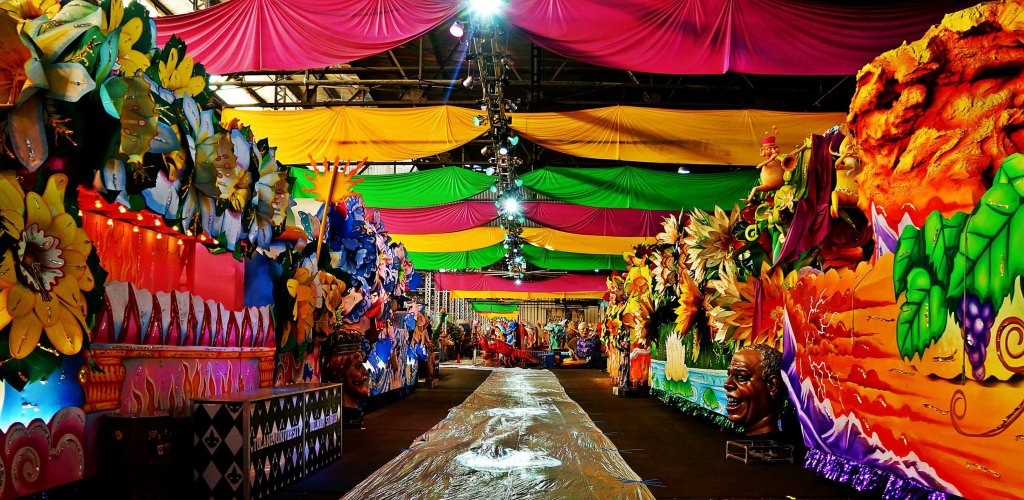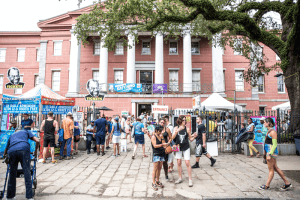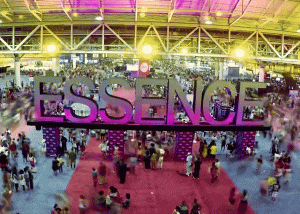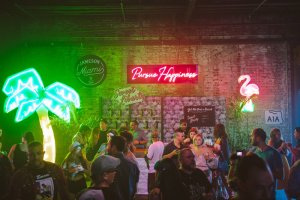Must-See Mardi Gras Museums

Photo courtesy of Mardi Gras World on Facebook
The magic of the Carnival is perpetually captured by these museums listed below, even outside of the season, which falls between January 6 (Twelfth Night, or Epiphany) and ends on Fat Tuesday, followed by the Lenten season starting on Ash Wednesday. Come admire the gowns and the tiaras, see how the floats are built, and learn just how much work goes into the fabulously beaded and feathered Mardi Gras Indian costumes. Trust us, you won’t find anything like this outside New Orleans.
Mardi Gras World
1380 Port of New Orleans Place
Mardi Gras World is located along the Mississippi River, next to the Morial Convention Center. More than 80 percent of the parade floats that you see on the streets of New Orleans during the Carnival season are designed and built at this 300,000-square-foot warehouse that belongs to Kern Studios. The history of Kern Studios dates back to 1947, when it was founded by float designer and builder Blaine Kern.
The guided tour covers the history of the Carnival that has begun in 1837 with floats pulled by mule-drawn carriages, including the balls, the krewes, and other traditions. If you want a tour, a Mardi Gras World shuttle can pick you up for free from one of the many designated locations downtown and in the French Quarter. There are no prearranged pickups, so just call 504-361-7821.
Also, feel free to take advantage of a free slice of King Cake offered at the end of the tour (it’s not easy to find out of season), and the great views of the Mississippi River from the on-site café.
The Presbytère
751 Chartres Street, Jackson Square
The Presbytère is located on Jackson Square, on the other side of St. Louis Cathedral. Known since the 18th century as Place d’Armes, this timeless landmark was renamed in honor of Andrew Jackson following the 1815 Battle of New Orleans. Jackson’s bronze statue is the focal point of the square, surrounded by lavish flora and facing the Mississippi River.
On the other side of the Cathedral is The Cabildo, where the 1803 Louisiana Purchase was signed. The Presbytère was built in 1791 in the style to match the Cabildo. It’s called “Presbytère” because it was built on the site of one, which served as a residence for Capuchin monks. The building served as a courthouse in the late 19th century and is now also part of the Louisiana State Museum, just like The Cabildo.
The Presbytère houses several temporary and permanent exhibits that tell the stories of resilience and exuberance. “The Living with Hurricanes: Katrina and Beyond” exhibit documents the natural disaster, its aftermath, and the ongoing recovery with interactive displays and artifacts.
The magnificent “Mardi Gras: It’s Carnival Time in Louisiana” tells the story of the Carnival traditions in Louisiana, including Cajun Courir de Mardi Gras, Zulu coconut throws, 19th-century Rex ball costumes, and much more. It’s an elaborate collection complemented by interactive exhibits that trace the celebration back to when it started to its present day, including a unique look at how Mardi Gras is celebrated in Louisiana’s rural areas. It’s a must-see museum in the French Quarter, and don’t skip the treasure trove of a gift shop.
Mardi Gras Museum of Costumes & Culture
1010 Conti Street
The Mardi Gras Museum of Costumes & Culture is located between N. Rampart and Burgundy streets in the French Quarter and features the private collection of its owner, Carl Mack, a costumer and entertainer known as The Xylophone Man. It’s one the largest personal collections of Mardi Gras costumes in the city, and it tells the story of the walking clubs, masquerade balls, Mardi Gras Indians, krewe royalty, Social Aid and Pleasure clubs, and Cajun Mardi Gras. The costumes on display include those worn by the Kings and Queens of various krewes, including those worn by Irma Thomas, Al “Carnival Time” Johnson, and the King and Queen of the Tremé Sidewalk Steppers.
The museum’s gallery features four exhibits a year and hosts special events. You can also experience Mardi Gras for yourself by playing dress-up for fun and the selfies in the museum’s vast costume closet.
Mardi Gras Museum at Arnaud’s
813 Bienville Street
This small museum dedicated to the Carnival is located inside the sprawling grande dame of elevated Creole dining, Arnaud’s. The restaurant was founded in 1910 by Arnaud Cazenave, a colorful French salesman who later acquired the honorary title of the Count. The museum opened in 1983 and is named after Germaine Cazenave Wells, Count Arnaud’s daughter, who reportedly reigned as queen of 22 balls between 1937-1968, which is more than any other woman in the history of Carnival.
The collection consists of a couple of dozen of elaborate costumes, both children’s and adult. The oldest costume dates to 1941 and the most recent one is from 1968. The costumes include 13 that belonged to Germaine Cazenave Wells, as well as four of her father’s when he reigned as king, plus her mother’s and daughter’s. The museum’s collection also includes masks, costume jewelry, vintage photographs, party favors, and krewe invitations.
Backstreet Cultural Museum
1531 N. Philip Street
Located in Tremé, which is the area adjacent to the French Quarter right across N. Rampart Street and the oldest African-American neighborhood in the United States, the Backstreet Cultural Museum is as unique as the city itself. It explores the rites and practices of the city’s African-American population that are also interwoven with the French-Creole history of New Orleans. You’ll be led on an unforgettable tour of memorabilia indigenous to Mardi Gras, jazz funerals, second lines, Super Sunday, and other traditions that cannot be found anywhere else in the world.
The museum hosts the largest collection of Mardi Gras Indian costumes in the city. Those are fantastic creations made of beads, feathers and sequins that cost thousands of dollars, weigh hundreds of pounds, and require hundreds of days of painstaking labor, as no element of costume creation is automated. The museum’s collection also includes photos and video footage of Mardi Gras Indians, jazz funerals and second lines.
If you want to see Mardi Gras Indians on the march, the fantastically evocative costumes of the North Side Skull & Bones Gang, and the dazzling performances of the Baby Dolls, head to the Backstreet Cultural Museum early on Mardi Gras Day morning. The North Side Skull & Bones Gang gathers at the Backstreet Cultural Museum and then sets off to wake up the neighborhood on Fat Tuesday, according to the tradition started in the 1800s. You never know when the Mardi Indians show up and where, but the Backstreet Cultural Museum is a reliable spot to catch them.
Are you planning to spend some time in New Orleans soon? To stay close to all the action, book a historic boutique hotel in the French Quarter at FrenchQuarter.com/hotels today!






